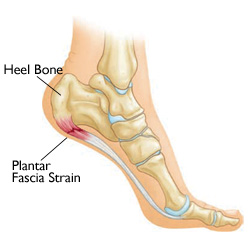
This series of articles will be focusing on the major “itis’” of the body. Over the next few weeks get excited to learn about the pathology, diagnoses and treatment of the major inflammatory conditions of the musculotendinous tissue throughout our body. “itis” translates medically as an inflammatory condition. These conditions are generally caused by chronic repetitive overuse of a structure over a particular time. Acute injuries are not to be ruled out to be causative factors. It is possible to have an acute injury that is hidden “occult” that can turn into a chronic problem over the course of several weeks or months.
The Plantar Fascia is a thick fascia structure that extends from the base of our heel outward to all 5 toes. It’s purpose is to create stability throughout our foot in order to help aid with proper mechanics during walking, running , jumping and all weight bearing activities. Plantar Fascitis (PF) is small or large fibrotic tears of the fascia tissue itself. Overtime scar tissue will form to bridge the gaps between the torn tissue. This is how the body attempts to heal itself. Scar tissue can tend to be tight tissue that overtime will become more elastic. At night during sleep the tissue tends to shorten due to our foot position, in the morning pain throughout the fascia reappears. This is a classic sign of inflammation through the foot and/or Achilles tendon.
PF stems from 3 major different areas.
- Excessive or late pronation: The arch collapses too much or too late in heel to toe action during weight bearing activities.
- Poor foot structure : The joints in the foot move too much or too little, the muscles in the feet, ankle, arch and lower leg are not efficient and/or the ligaments in our feet are loose or “lax”.
- Improper shoes for your specific foot structure: These include dress, flip flops and high heels.
PF is treated systematically: decrease inflammation + restore normal motion/strength + restore proper foot mechanics= return to normal activities pain free
- Modify stresses to the feet
- Decrease mileage and time spent on feet
- Stretch fascia and supporting lower leg muscles
- Myofascial release
- Strengthening program
- Proper shoes ALL the time
- Custom Fitted Orthotics (Evaluations available through our 4S location)
- Physical Therapy assessment when pain exceeds 2 wks
- Slow progression back to normal activities
There is no reason you should have to live with daily pain, There are resources all around you in order for you to experience a pain free STRONGER, FASTER, MORE EFFICIENT, HAPPIER YOU!!

